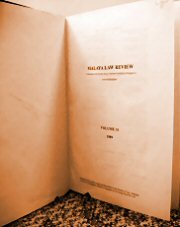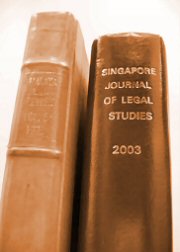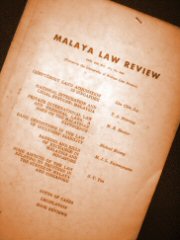|
Archive |
2386 records match your query:
| 241. | DECEMBER 2014 Issue | p.377 | |
| | The Subsumation of Maintenance and Champerty Under Third Party Orders
Zhuang WenXiong • [2014] Sing JLS 377 (Dec)Maintenance and champerty were historically torts and crimes under English law, and the case can be made that they technically remain so under Singapore law. It would, however, be better to deal with third party litigation funding within the rubric of third party orders—at the interlocutory stage, for the third party to provide security for costs, and at the close of proceedings, for the third party funder to be liable for costs. This would jettison archaic and technical English case law relating to maintenance and champerty, and enable the Singapore courts to transparently facilitate access to justice whilst reigning in unwarranted forms of third party funding.
| | 242. | DECEMBER 2014 Issue | p.397 | |
| | Legislation and Case Notes: Nuisance by Noise—The UK Supreme Court on Interference with the Use and Enjoyment of Land
Margaret Fordham • [2014] Sing JLS 397 (Dec)Private nuisance cases rarely come before the United Kingdom's (UK) highest court and cases focusing on interference with the use and enjoyment of land (rather than physical damage or encroachment) are rarer still. Indeed, although there was some discussion of this aspect of private nuisance in Hunter v Canary Wharf Ltd, the last case at the highest level fully to canvass the factors relevant to a claim for interference with use and enjoyment of land was St Helen's Smelting Co v Tipping, decided by the House of Lords in 1865. Now, in Lawrence, the Supreme Court has been called on in a claim relating to noise to determine a number of questions, some focusing specifically on the nature of a nuisance which offends the senses and others raising points of more general application. They include the relevance of prescriptive rights and 'coming to the nuisance', the significance of both a defendant's activity and the planning permission for that activity when determining the character of the neighbourhood in which the activity takes place, and the circumstances in which damages, rather than injunctions, should be awarded in successful actions for nuisance.
| | 243. | DECEMBER 2014 Issue | p.408 | |
| | Legislation and Case Notes: The 1994 Practice Statement and Twenty Years On
Lau Kwan Ho • [2014] Sing JLS 408 (Dec)The power of the Court of Appeal to overrule or depart from one of its previous decisions is well known to lawyers in Singapore. Asurvey of the jurisprudence shows that this power has, in the two decades since the Practice Statement (Judicial Precedent) was handed down, been exercised both usefully and appropriately. It confirms what many have suspected for a while now: the Court of Appeal has truly come into its own as arguably the leading exponent of the common law in Asia, with its judges possessing practical and scholarly expertise in equal measure.
| | 244. | DECEMBER 2014 Issue | p.419 | |
| | Legislation and Case Notes: Common Intention and the Presumption of Joint Possession in the Misuse of Drugs Act
Ivan Lee • [2014] Sing JLS 419 (Dec)In 2010, the Singapore Court of Appeal thoroughly reviewed the doctrine of common intention under s 34 of the Penal Code in the landmark decision of Daniel Vijay s/o Katherasan v Public Prosecutor. The present case is the first drug trafficking case involving this provision to reach the Court of Appeal since then. For the most part, Ridzuan reads like a straightforward and unremarkable case. The appellant Ridzuan was convicted at the High Court with his partner-in-crimeAbdul Haleem for trafficking in an amount of heroin large enough to attract the mandatory death penalty under the Misuse of Drugs Act. Abdul Haleem did not appeal his conviction because he had received a certificate of cooperation from the prosecution and benefited from the attendant discretion given to the trial judge to commute his sentence to life imprisonment with caning. Ridzuan, however, did not qualify for the certificate, and consequently filed this appeal which the Court of Appeal dismissed. The judgment itself contains little by way of uncertainty or controversy over the applicable law on common intention, as the court readily dealt with the issue by following its earlier pronouncements in Daniel Vijay. The appeal also did not turn on this issue as the court was thorough enough to find Ridzuan not only constructively liable for his complicity in Abdul Haleem's act, but also liable as a principal offender for satisfying the elements of the offence of trafficking. There is ultimately very little in the judgment to support any serious argument that the outcome for Ridzuan, unfortunately for him, could have been any different
| | 245. | DECEMBER 2014 Issue | p.429 | |
| | Legislation and Case Notes: Sins of the Father
Colin Liew • [2014] Sing JLS 429 (Dec)In White v Jones, the House of Lords controversially extended liability in the tort of negligence to solicitors who had caused economic loss to a third party by failing to take proper care in drawing up a will for their client, supposedly on the basis of an “assumption of responsibility”. In Anwar, the Court of Appeal has now sought to rationaliseWhite within the analytical framework laid down in Spandeck Engineering (S) Pte Ltd v Defence Science & Technology Agency.
| | 246. | DECEMBER 2014 Issue | p.443 | |
| | Book Reviews: Tort Law Defences by James Goudkamp
Kumaralingam Amirthalingam • [2014] Sing JLS 443 (Dec)James Goudkamp's recent publication, Tort Law Defences, is a bold work that is exploratory and provocative, challenging conventional thinking about tort law. It was awarded joint Second Prize for the 2014 Society of Legal Scholars Peter Birks Prize for Outstanding Legal Scholarship. The last two decades have seen considerable academic work on tort law, largely focused on theoretical frameworks for analysis of the positive elements of torts. There has, however, been little effort given to analysing tort law defences as a unified field, unlike criminal law scholarship, which has devoted itself for decades to theorizing about criminal law defences.
| | 247. | DECEMBER 2014 Issue | p.446 | |
| | Book Reviews: Arbitration in China: A Legal and Cultural Analysis by Kun Fan
Gary F Bell • [2014] Sing JLS 446 (Dec)I am pleased to review this very interesting, well-researched and well-written book on arbitration in China. The author properly delivers on the second part of the title of the book: “A Legal and Cultural Analysis”.
| | 248. | DECEMBER 2014 Issue | p.449 | |
| | Book Reviews: The Privilege Against Self-Incrimination and Criminal Justice BY Andrew L-T Choo
Ho Hock Lai • [2014] Sing JLS 449 (Dec)This is a book on the privilege against self-incrimination by a leading academic on criminal evidence and procedure. His work, particularly on the abuse of process and judicial stay of proceedings, has influenced decisions of the highest court in the United Kingdom and the Privy Council. The privilege against self-incrimination lacks a clear and widely accepted meaning. A helpful definition is provided in s 4 of the New Zealand Evidence Act 2006 (NZ), 2006/69. It is used by the author as a framing device. According to that definition, the privilege is the rule that a person may not be compelled, on pain of criminal sanction, to provide information that may lead to or increase the probability of his criminal prosecution. The focus is on the law in England and Wales as shaped by the jurisprudence on the European Convention on Human Rights [ECHR]. Comparative materials from the United States, Canada, Australia, New Zealand and India are also taken into account. As the author explains, the aim is to “highlight the doctrinal and theoretical issues that are of particular contemporary concern.” (at p vii) He has succeeded well in this objective.
| | 249. | DECEMBER 2014 Issue | p.452 | |
| | Book Reviews: The Law of Contract Damages by Adam Kramer
Irene Ng (Huang Ying) • [2014] Sing JLS 452 (Dec)Damages—this is an unavoidable word in almost any kind of contractual dispute, and is of critical importance to the practitioner as it usually determines whether a suit should even be commenced. Where damages are concerned, it is more often than not a question of “how much?” Indeed, there are many species of damages such as compensatory, nominal, punitive and liquidated damages, and of all species of damages, the calculation of compensatory damages is perhaps the most complex. A large bulk of Kramer's The Law of Contract Damages (Oxford: Hart Publishing, 2014) is therefore devoted to addressing this question.
| | 250. | JULY 2014 Issue | p.1 | |
| | Islamic Insurance in Malaysia: Insights for the Indian Insurance Industry
Mohit Anand • [2014] Sing JLS 1 (Jul)This article looks at the development and characteristics of Islamic insurance (takaful) which is compatible with the principles of Islamic finance, thereby making it acceptable and attractive for millions of Muslims as an alternative to conventional insurance. In so doing, this article provides a detailed review on the evolution of takaful in the context of the Malaysian insurance sector which is among the largest players in the global takaful market. Taking cues from the success of takaful in Malaysia, this article explores certain key tenets of takaful and micro-takaful (low-cost takaful) that can be translated specifically into the indian context when the market eventually opens up and possibly into other developing and developed markets with substantial Muslim populations.
| |
|
|


 |







